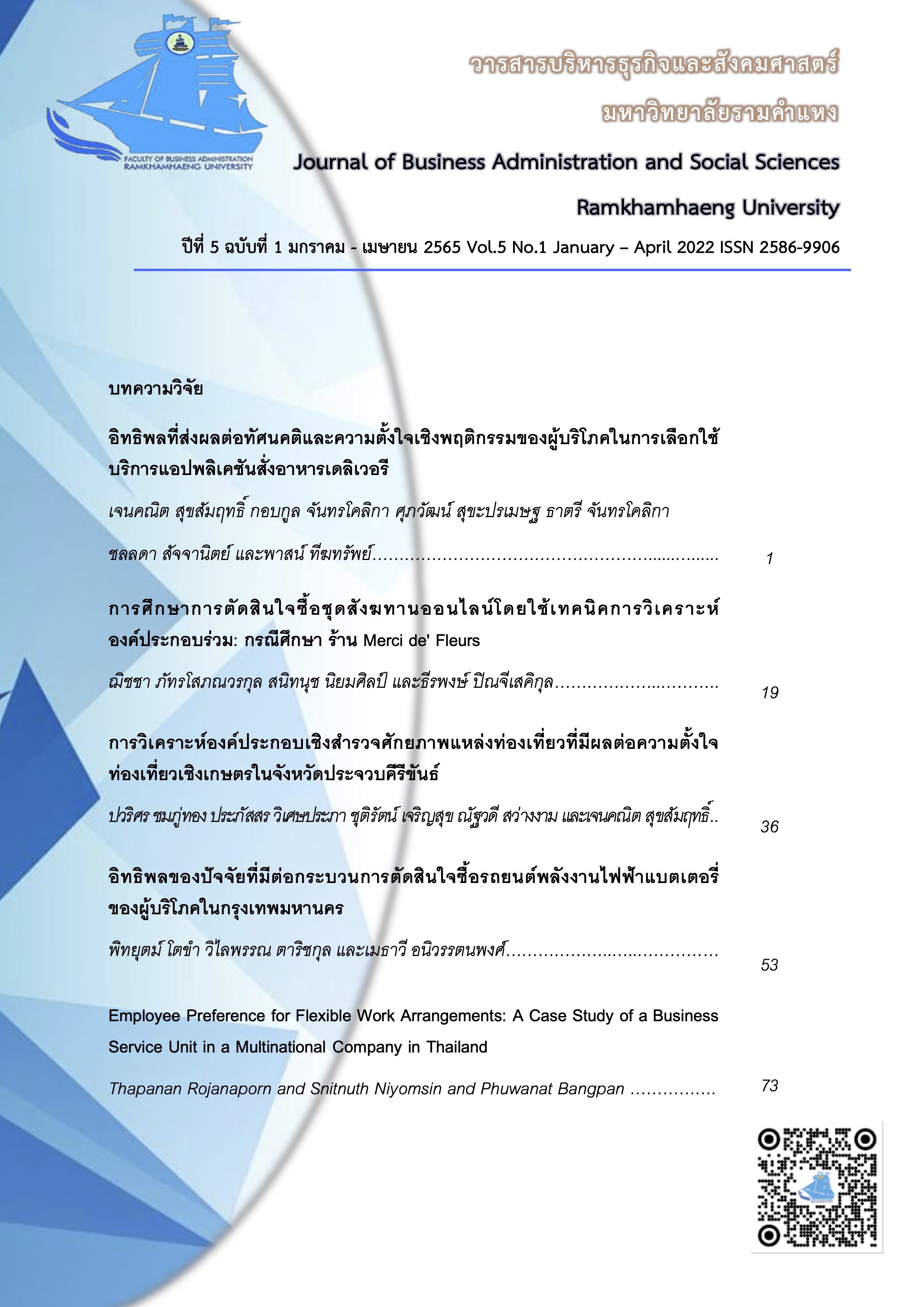A Study of Online Buying Decision for Merit Offering Sets Using Conjoint Analysis: A Case Study of Merci dé Fleurs
Main Article Content
Abstract
Article Details

This work is licensed under a Creative Commons Attribution-NonCommercial-NoDerivatives 4.0 International License.
เนื้อหาและข้อมูลในบทความที่ลงตีพิมพ์ในวารสารบริหารธุรกิจและสังคมศาสตร์ มหาวิทยาลัยรามคำแหง ถือเป็นข้อคิดเห็นและความรับผิดชอบของผู้เขียนบทความโดยตรง ซึ่งกองบรรณาธิการไม่จำเป็นต้องเห็นด้วย หรือร่วมรับผิดชอบใดๆ
บทความ ข้อมูล เนื้อหา รูปภาพ ฯลฯ ที่ได้รับการตีพิมพ์ในวารสารบริหารธุรกิจและสังคมศาสตร์ มหาวิทยาลัยรามคำแหง ถือเป็นลิขสิทธิ์ของวารสารบริหารธุรกิจและสังคมศาสตร์ มหาวิทยาลัยรามคำแหง หากบุคคลหรือหน่วยงานใดต้องการนำบทความทั้งหมดหรือส่วนหนึ่งส่วนใดไปเผยแพร่ต่อ หรือเพื่อกระทำการใดๆ จะต้องได้รับอนุญาตเป็นลายลักษณ์อักษรจากวารสารบริหารธุรกิจและสังคมศาสตร์ มหาวิทยาลัยรามคำแหง ก่อนเท่านั้น
References
ทัศไนย เขียวมณีนัย. (2559). ปัจจัยที่มีอิทธิพลต่อความตั้งใจซื้อสังฆทานสำเร็จรูปในเขตเทศบาลนครหาดใหญ่, วิทยานิพนธ์พุทธศาสตรมหาบัณฑิต, สงขลา: มหาวิทยาลัยสงขลานครินทร์.
พระชลญาณมุนี (สมโภช ธมฺมโภชฺโช) และสรวิชญ์ วงษ์สอาด. (2563). พระพุทธศาสนากับความเชื่อ (Buddhism and belief). วารสารมหาวิทยาลัยมหาจุฬาลงกรณราชวิทยาลัย บาฬีศึกษาพุทธโฆสปริทรรศน์, 6(2): 99-115.
พระมหาธนากร ลาภเอกอุดม. (ม.ป.ป.). ส่วนประสมทางการตลาดสังฆภัณฑ์ในเขตบางนา กรุงเทพมหานคร, บริหารธุรกิจมหาบัณฑิต, มหาวิทยาลัยปทุมธานี, ปทุมธานี, 6-8.
พระศิริปญฺญามุนิ (อ่อน). (2506). คัมภีร์มงคลทีปนีแปล. กรุงเทพมหานครมหานคร: โรงพิมพ์เลี่ยงเซียงจงเจริญ.
มนตรี พิริยะกุล. (2555). Conjoint Analysis. วารสารรามคำแหง, 29(2): 252-272.
สำนักงานสถิติแห่งชาติ. (2561). ข่าวประชาสัมพันธ์สํานักงานสถิติแห่งชาติ, สืบค้นจาก http://statbbi.nso.go.th/staticreport/page/sector/th/
เฉลิมชัย สุวรรณวัฒนา. (2553). สีในวัฒนธรรมความเชื่อของไทย. วิทยานิพนธ์ ปริญญาศิลปศาสตร์มหาบัณฑิต. กรุงเทพมหานคร: มหาวิทยาลัยศิลปากร.
Borden, H. N., (1984). The Concept of the Marketing Mix, Harvard Business School, 2, 7-13.
Green, E. P., Kriege, M. A., & Wind, Y., (2001), Thirty Years of Conjoint Analysis: Reflections and Prospects, Interfaces, 31(3): S56-S73.
Gusafsson, A., Hermann, A., & Huber, F. (2003). Conjoint Measurement Method and Application. (3rd ed.). New York: Springer-Verlag Berlin Heidelberg.
Hair, F. J., Anderson, E. R., Tatham, L. R., & Black, C. W. (1998). Multivariate Data Analysis (5th ed.). New Jersey: Prentice-Hall College Div.
Hair, F. J., Black, C. W., Babin, J. B., & Anderson, E. R. (2010), Multivariate Data Analysis: A global perspective (7th ed.). New Jersey: Pearson Education, Inc.
Kotler, P., & Armstrong, G. (2021). Principles of Marketing (18th global ed.). New Jersey; Pearson Education Limited.
Orme, K. B. (2010). Getting Started with Conjoint Analysis: Strategies for Product Design and Pricing Research. (2nd ed.). United States of America: Research Publishers LLC.
Thabit, T. H., & Raewf, B. M. (2018). The Evaluation of Marketing Mix Elements: A Case Study. International Journal of Social Sciences & Educational Studies, 4(4), 100-109.


